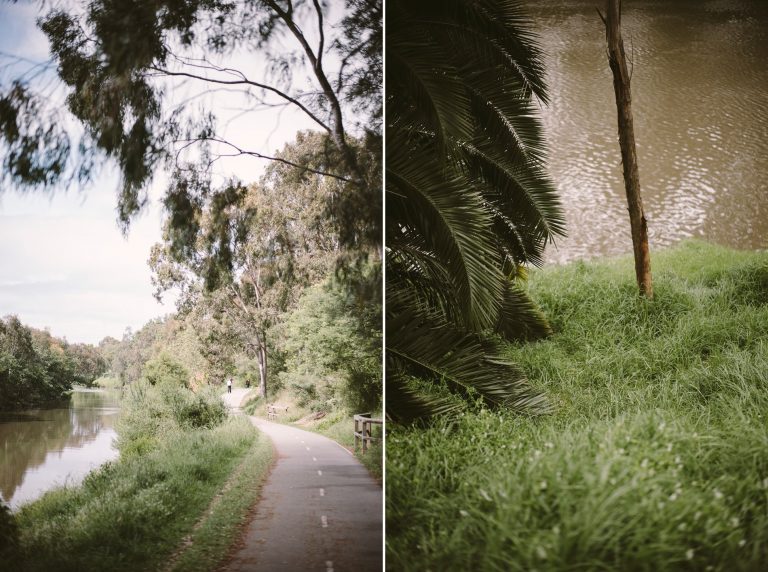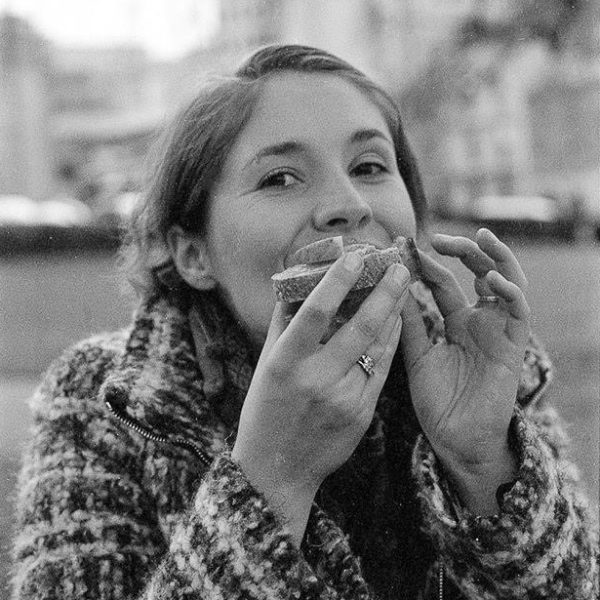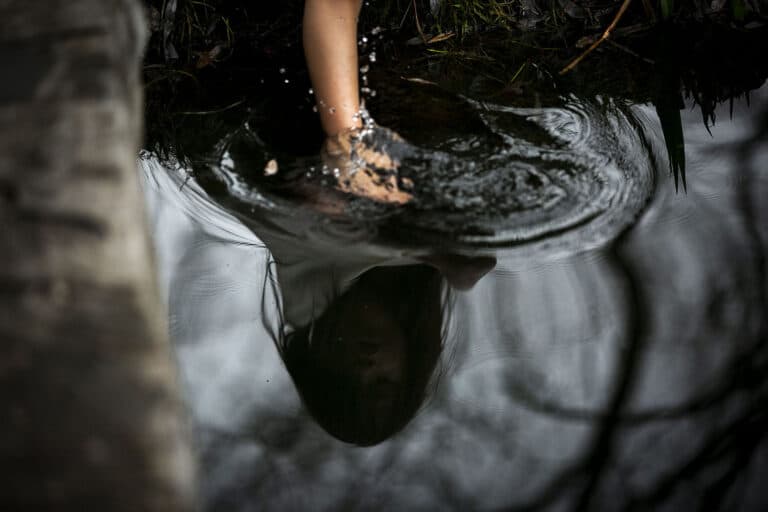
Image by Kyle Larson/Kyle Larson Photography, © All Rights Reserved.
In Praise of Mists and Shadows
A silt-stained river runs through the stolen land on which I live, and lately a joke the locals tell about it runs through my mind. Birrarung. The Yarra. That River of Mists hulking towards the sea? It’s the only river in Australia that runs upside down. The clear water’s underneath.
Two springs ago I attended a wedding. The groom’s mother had been unwell for some time and passed away just three evenings before the ceremony. I barely knew the couple then but knew through my own experience of loss a fraction of what they might be feeling. Instead of a spring wedding, we gathered in remembrance. It was the first truly warm day of the changing seasons, and as we stood on the north bank of the Yarra’s canal in the city I sent quiet prayers for his family as they held the day’s strangeness, togetherness, and distance.
Six months later, on the first cool weekend of autumn, the wedding was rescheduled. It was a day rich in love and tenderness that palpably filled the air. As the ceremony concluded, we threw colored confetti over the bride and groom and it felt as though his mum hovered amongst us — colorful, joyous, and free. That, as Alice Sebold writes in The Lovely Bones, her spirit truly did “bob and weave and laugh with us,” in the space between the living, as the oxygen we breathed.
Our procession moved through the city crossing the Yarra at Princes Bridge. We arrived at the reception venue at Southbank, found our table places and began to eat, drink, and dance. As evening sunk into night I came up for air from the dance floor and walked towards the high concrete balcony overlooking the river. Looking across the water, which is only ever blue in the dark as it reflects the city’s lights, my eyes spanned the canal towards the north bank resting on the exact spot we met to remember the groom’s mother the previous spring.
How right it felt to have crossed the river together that day and look back across its shadowy water, to remember the unknowable depths those closest to the family had waded through to stand together in love and celebration on the other side.

From where the Yarra’s headwaters gather northeast of Melbourne, it takes three days for rainwater collected in the highlands to reach the sea through Boon Wurrung land at Port Phillip. It’s hard to pinpoint exactly where a river begins. The water snaking through Melbourne gathers in the hills as a result of rainfall in the mountains, and that rainfall gathers as the effect of evaporation from the sea. Aren’t oceans where rivers end, not begin?
Three days after the wedding, I found myself at the reception venue again. This time to toast a friend’s divorce. Crossing the river again that night, I imagined the depths she too had swum through towards freedom and the possibility of new life. The water flowing beside us as we celebrated her bravery would have gathered in the hills the day of the wedding. Now as we sat amidst the concrete behemoths of Southbank it would be passing us towards the home of all healthy rivers, the sea.
The streamlined canal we see in the city is a shadow itself of the former river. Since colonization the water has been re-diverted, land reclaimed, and the riverbed quite literally blown up. It has been bridged, sailed upon, de-snagged to increase its smoothness and now re-snagged to slow the process of erosion which that original de-snagging sped up. Its billabongs have been severed to form lakes like that in the Royal Botanic Gardens, where eels still slither like living rivers themselves through the water table beneath the earth. Birrarung’s current powered the city’s first elevators, while its curves and meanders through Abbotsford once formed the backdrop for the colony’s first asylums, now the backdrop for some of the city’s most wealthy residents.
Tony Birch’s Ghost River recalls a tale of two boys whose days are as meandering as their river. It tells of the arrival of bulldozers, diggers, and cranes that demolished their Deep Rock, once home to the tallest free dives in the world, now leveled and home to the slowest freeway in Melbourne. The fact our city is so indebted to this river is enough to make you wonder if when Lord Melbourne foisted his namesake upon the land, he quietly pondered the etymology of his own name. Melbourne in Old English is Mileburne, a “mill stream,” a waterway used to power something else.
If you are reading this and live in Melbourne, the last drink of water you had is likely from the river’s catchment, the upper reaches of which have been closed off to protect our drinking water for over a hundred years. In my almost decade living here, I have swum in Birrarung’s waters once, yet I’m baptized by it each day as I shower. If the body is 70 percent water and we drink to replenish it, then perhaps blood is not thicker than water at all. Perhaps the Yarra is what unites us, and you and I are brothers and sisters in a faucet communion. By this reckoning it might be fair to assume that Birrarung, by way of being one of the few entities that has both enveloped my body externally and trickled through the blood-red darkness of my insides, knows me better than I know myself. That indeed this water does not belong to me, but as the Wurundjeri and neighboring Kulin nation tribes knew and know; I belong to it, that it and I are one.

That silt-stained river and the joke the locals tell about it brings a smile to my face, and if I am looking, within it lies an invitation. An invitation to explore the fabled clarity of depth that lies beneath the surface of the Yarra. An invitation to explore the clarity of depth that might lie beneath the surface of myself. Those depths of interior life that my friends who lost loved ones by way of death and broken promise had to wade through to reach the other side.
In Jun’ichirō Tanizaki’s essay In Praise of Shadows the author explores how darkness, shadow, and nature influence and are interwoven in Japanese design. In a memorable passage Tanizaki focuses on a room he describes as having the potential for architecturally “vexatious problems” to arise: the toilet. He writes:
“… the Japanese toilet is truly a place of spiritual repose. It always stands apart from the main building, at the end of a corridor, in a grove fragrant with leaves and moss. No words can describe that sensation as one sits in the dim light, basking in the faint glow reflected from the shoji, lost in meditation… Anyone with a taste for traditional architecture must agree that the Japanese toilet is perfection.”
The essay unfolds and Tanizaki venerates shadow, soft light, dimness, and depth throughout. His work grows like a fractal praising the space his culture’s architecture and even its food has allowed for the darkness of the unknown, the inevitable mystery in each room of life.
From the wood grain and lacquer of his ideal bathroom furnishings, to the paper shoji doors diffusing light between rooms, and the inky swirl of soy sauce in a dark resin bowl. Tanizaki contrasts this traditional allowance for shadow and depth with the way Western bathrooms have tried to annihilate it completely. Our white tiles, pristine surfaces, and surgically bright lights illumining every inelegant fold of flesh or stray hair. That Western bathroom I am so accustomed to: flooded with downlights, sharp lines, and towering angular mirrors, set to the tune of a monotonous fan like the one in my bathroom. The fan that sucks out some of the only mists that still hover around my experience of the River of Mists itself, the soft condensation suspended mid-air after a hot shower.
When settlers came to Australia, we brought ideals, flora, and fauna. In the blink of an eye we have rendered parts of this land unrecognizable, building a new architecture that has done its best to exile tribes who have known this land most intimately for up to 65,000 years. Early paintings of the Yarra depict its water as blue and clear or right side up, and Maya Ward the river pilgrim echoes this, recalling the way the water once ran clear down to falls at Queens Bridge, a site of cultural importance to Kulin tribes and the separation between salt and freshwater before they were TNT’d away.
However in Kristin Otto’s Yarra she reminds us that “Australian rivers are noted for their turbidity… and the Yarra is an Australian river. The colors of the Yarra are the colors of our country, literally, being suspended earth from the upstream and middle-stream banks.” That golden-brown mud with the slightest tinge of ochre is the color of this land, and I cannot help wonder if the cornflower-blue surface of the river and the editing of Birrarung’s color in those early paintings might have foreshadowed the editing of color in the population itself.

One of the great modern explorers of what it is to be human, the founder of analytical psychology, Carl Jung excavated this idea of the need to allow space for the unknown, the shadow in the architecture of our own psyches, our souls. Jung defined the “shadow self” as either an unconscious aspect of the personality which the conscious ego is unaware of or the entirety of the unconscious itself. For Jung, the shadow is our dark side, a side each of us possesses. It is the side I most wish to ignore. It is my selfishness and jealousy, my judgmental nature, egotism, schemes, and plots. It is an archetype that, if gone unchecked, may have a free hand in the life of its host, projecting and realizing its own potentially calamitous desires as it goes.
At first glance the shadow could be easily dismissed as merely negative, turbid, unclean, but as with the Yarra, Jung believed that, if we are to go out beyond the shallows, we may find unplumbed clarity in the depths. Jung describes this lifelong process of accommodating our shadow in four repeating stages. First, the shadow appears; we then encounter it and begin to merge with it. In these initial stages, he acknowledges the shadow presents “a tight passage, a narrow door, whose painful constriction no one is spared,” as they embark on that perilous descent into what Jung uses another watery symbol to describe: “a deep well.”
But I want to talk about possibility and hope and clarity, the kind of which could lie within us if we would grant ourselves time to sit with it. Jung himself held firm that “after the inevitable descent” into the shadow “an ascent will always follow.” That once we have begun to integrate it into our conscious, we would start “to travel [up] through healing spirals,” becoming stronger and more whole. That by knowing our darkness, not simply our light, we become more fully able know ourselves and one another. He called this final stage “enantiodromia,” a Greek word meaning “opposite running course,” which follows the principle that the extreme abundance of one energy will inevitably produce its opposite.
This turbid river is a mystery in plain sight, and so are we.
We can spend our lives in the shallows. We can move through our days veiled, our faces a mere précis of features rather than the nuanced topography of scars, wrinkles, tears, and smile lines, which in part tell our stories and speak of our depths. We can seldom take time to know ourselves and each other, for it requires the Herculean effort of diving beneath our own surfaces. Hercules — that Greek god made human — who, in recent adaptations of the original myth, crossed the most foreboding river of all, the Styx, the liminal waterway between life and death itself for love. Perhaps in exploring our shadows, our interior lives, we may find that we ourselves are the ones who need ferrying back to life from time to time.

What shadows did my friends encounter when they lost loved ones, got married, or dared to believe in a life where a more complete love could exist? How dark was the water they sunk into? How long cast the shadow of their experience, and when did they begin to ascend in healing spirals? What lives of richness are yet to unfold before them? And if I can be brave like they have been, facing my own shadows both personally and historically, what wholeness of a new future might unfold before me? I hope my friends’ abundance is manifold, and I hope yours and mine can be too.
Kristen Otto says “the appearance of the Yarra water is something people have been dealing with for a long time. It was once known as one of the filthiest rivers in the world.” Yet it has sustained, and continues to sustain, the oldest living civilization on earth as well as us blow-ins, too. She proposes “most of us have spent our lives confusing turbidity with dirtiness and wondering why our messy natural bushscapes weren’t Derwent colored-pencil sketches. We are only just getting used to being Australian.”
If we are only just getting used to being Australian, and we have been in this place for such a fraction of time, and if time is a place, and our species has existed within it for a fraction, could it also be true that we are only just getting used to being human? Perhaps this river, if accepted as-is, loved as-is, even praised for its shadows, might allow me to become more comfortable with my own turbidity and my humanity. It might encourage me to descend and trust in a more whole ascent on the other side. For as Maya Ward knew under the shadow of night during her walk from the mouth of the river to its headwaters, “there are undercurrents between us, dark and swirling and muddy.” That the hearts of others, perhaps even our own hearts, are like “secret underground watercourses that run somewhere below,” and that we can “trust what is turbid will clear when the time is right.”
Lovers of real-life magic will take heart in knowing that in parts the Yarra really is clearer underneath. That, as Kristen Otto writes, “fresh and salt water do actually layer themselves in the lower reaches of the river: the fresh — that is, the warm, muddy water flowing down on top, and the heavier seawater flooding in clear below. You can see it in the wake of big ships in the Port of Melbourne as their propellers churn up clear water from the bottom,” and from time to time police divers report seeing “two meters of good visibility underneath half a dozen of suspended sedimentary darkness.” As the Yarra reaches its own extremities at the mouth of Port Philip, not only is the joke on us as Birrarung turns upside down, but sometimes it becomes back-to-front as well, entering its own enantiodromia as the weight of king tides push its flow in reverse, on an opposite-running course towards Dights Falls.
Ultimately, the River of Mists inclines towards the sea. Its end culminates in the waves that were its, and our species’, beginning, the waves that, if they continue to rise, may be our ending, too. Fresh water becomes salt water, the line between light and shade, clarity and turbidity becomes blurred, and what once flowed more or less in one direction is received and enfolded by the endless approach of the waves. Should those waves continue to rise, I hope I will have lived in the light of knowing my shadow, and being honest in the shadows of my experiences. I hope that you will have too.
Note: a week after presenting this essay, a landmark court decision in Australia saw Birrarung, The Yarra, returned to the traditional custodians of the land — the Wurundjeri people of the Kulin nation.


Share your reflection